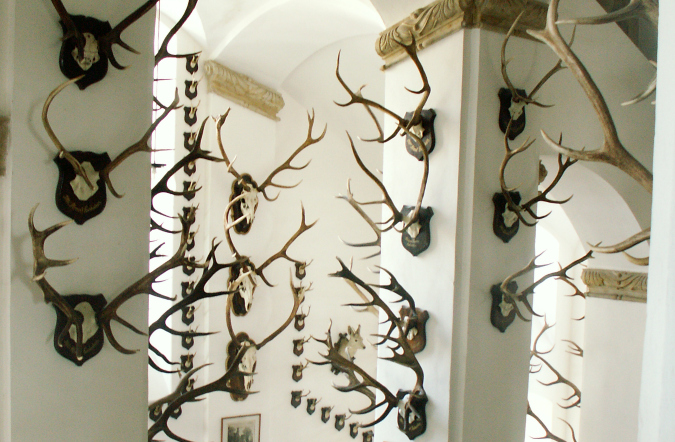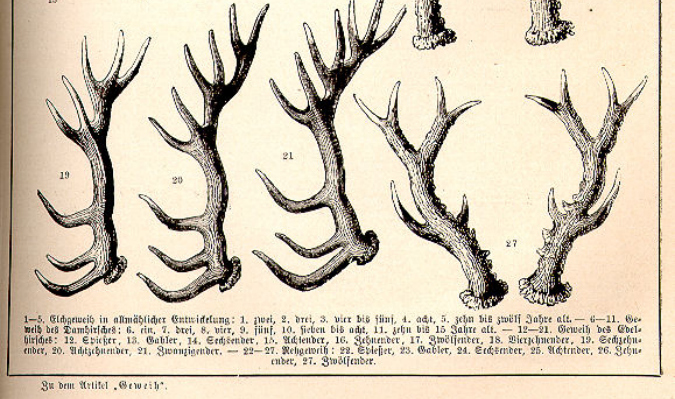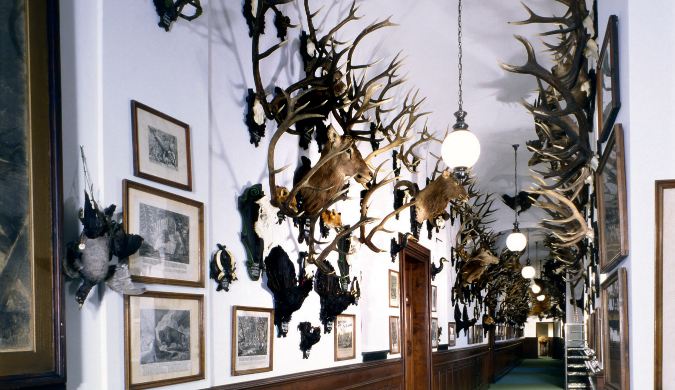Hunting has an undisputed role in the history of this part of Central Europe. The first mention of hunters in the Czech lands dates to the 11th century where, at hunts, rulers and nobles were surrounded by large groups of skilled huntsmen. Initially, hunting was tied to the land of rulers, nobles, monasteries and royal cities and special hunting castles while lodges were built to accommodate for its popularity with the elites. Historically, Emperor Ferdinand III issued provisions laying out hunting as a strictly noble pastime. As a result, to keep poaching and unauthorized hunting under control, gamekeepers were employed and trained.
Following a hunting patent issued by Joseph II, farming land was protected from damage by hunting activities, compensation established and large game ordered to be kept in controlled parks. As a result, large game was no longer as desirable and the focus shifted to smaller animals such as pheasants and does. The 19th century saw an emergence and boom of various pheasantries. New species of animals such as the chamois and the Japanese deer were imported, bred and now form the fauna one can encounter in the wild. When serfdom was abolished in 1848, the first imperial gamekeeper law came into effect. It meant that hunting became available to not just the nobles but also to common people and hunting rights were granted by the owner of the land.

Úsov Chateau in Moravia, home to the Hunting & Forestry museum
Who can go hunting?
Nowadays, since the hunting is governed by a legal code (Zákon č. 449/2001 Sb., o myslivosti) and gamekeeping associations are individual legal entities, hunting can be said to have emancipated itself and become an accessible hobby (and responsibility) for almost anyone. In the Czech Republic, most hunters belong to gamekeeper associations which usually rent the land they hunt on. All hunters must have a valid hunting license (issued for an indefinite period after having passed the gamekeeper license exam) as well as a hunting permit granted by the owner of the land. For foreigners, a hunting license can be issued for a period of 1/5/30 days or 6/12 months. Any applicant must prove that he/she does not have a criminal record as well as meet the minimum age, etc. Alternatively, one can be a host to a gamekeeper association or to someone’s private property. However, there is always the need to have a valid hunting license and hunting permit. When one is shooting a rifle, he/she must also have a valid gun license (License group C).
TIP:Myslivost.cz and Česká Zbrojovka in the Pánská pasáž are good shops for hunting clothing and gear. Yet another favorite for hunters is the Frankia Lov shop on náměstí Ivana Petroviče Pavlova 1787/1, in close proximity to the I.P. Pavlova metro stop.
What can be hunted and when?
The hunting season is also set by law. The dates when hunters can hunt certain animals are clearly specified and need to be followed. These dates were determined based on the breeding cycles of the animals in question. The amount of animals that can be hunted is determined on a yearly basis based on the local populations (rules also stipulated by law). If they are too many in number, their numbers must be controlled and if they are too few, they are protected. The key is to ensure equilibrium in the population levels. The animals which can be legally hunted are classified into two groups: furred and feathered game. Some hunting methods used in other countries are not allowed. For example using a crossbow or bow is prohibited. Falconry is allowed, but only at certain times of the year and only for certain types of animals. Here are the types of animals one can hunt and dates that they can be hunted in:

Manual to Central European game species
Furred game seasons
Deer, doe and fawn of the Red Deer 1.8.–15.1
Deer, doe and fawn of the Manchurian Sika Deer 16.8.–31.12
Deer, doe and fawn of the Japanese Sika Deer 1.8.–15.1
Fallow deer, doe, dance 16.8.–31.12
Deer, doe and fawn of White-tailed Deer 1.9–31.12
Doe deer 16.5–30.9
Doe, roe 1. 9.–31.12
Mouflon (male, female, offspring) 1.8–31.12
Wild boar and sow of wild boar 1.8–31.12
Pig and wild boar yearling 1. 1. – 31. 12
Buck, goat and kid of the Bezoar Goat 1.9–31.12
Chamois (male, female, offspring) 1.10.–30.11
Hare 1.11–31.12
Hare (capture only) 1.1–31.1
Hare (only birds of prey) 1.9–31.12
Rabbit 1.11–31.12
Badger 1.10. –30.11
Red Fox 1.1– 31.12
Pine Marten and Beech Marten 1.11–28.2
Muskrat 1.11–29.2
Feathered game seasons
Pheasant-cock 16.10.–31.12
Pheasant-cock and hen pheasant only in pheasantries 16.10–31.1
Pheasant-cock and hen (capture only) 1.1–31.3
Pheasant-cock and hen (capture only in pheasantries) 1.2–31.3
Pheasant-cock and hen (only birds of prey) 1.9–31.12
Reeves’s Pheasant – cock 16.10–15.3
Reeves’s Pheasant – hens (only in pheasantries) 16.10–31.12
Wild Turkey – cock 15.3–15.4
Wild Turkey and turkey 1.10–31.12
Bean Goose, Greylag Goose, Greater White-fronted Goose 16.8–15.1
Mallard, Pochard, Tufted Duck 1.9–30.11
Eurasian Coot 1.9–30.11
Helmeted Guineafowl 16.10–31.12
Common Wood Pigeon 1.8–31.10
Collared Dove 16.10–15.2
Magpie 1.7–28.2
Carrion Crow 1.7–28.2

Trophy hall at Konopiště Castle
Controlling population numbers and protecting nature
Gamekeepers are responsible for keeping our natural environment, often upset by growing human urbanization and infrastructure, in a carefully controlled balance. For example, in recent years, the wild boar numbers have been soaring across Europe causing a decline in the numbers of other wild species as well as causing severe damage to the forests themselves. Since wild boars have no natural predator, they can roam free and breed uncontrollably upsetting local ecosystems. For these reasons, in the 2011 season alone, some 141,000 wild boars were killed – many in the attempt to keep the population spiraling out of control. In comparison, in the winter of 1970/1971, a mere 4803 wild boars were killed. Aside from animal population control, gamekeepers have historically had the responsibility to protect the natural habitat they oversee by caring for the trees and plants as well. This often goes hand in hand with animal control and targeted feeding in winter months.
What happens to the animals?
What happens to the animals that were hunted down? Usually, these animals are consumed either by the hunters and their families or sometimes, their parts used as decorative trophies. Many of the wild boars, deer and doe deer end up on our plates. The demand for venison is considerable and forms an indispensable component to many classical Czech food variations, including but not limited to guláš, svíčková and others. Many of the gamekeeper associations sell the meat they do not need themselves to various distribution companies, which are then responsible for its distribution to restaurants and other outlets. Since most of the meat from wild animals is subjected to more parasites and possible disease, veterinary testing of the meat takes place prior to human consumption.
The future of hunting and gamekeeping
The future of hunting rests largely on the attitude towards the function gamekeepers and hunters have in the eyes of the public. It also depends on the numbers of hunters and gamekeepers willing to take this on as a hobby not just to hunt, but also to protect and maintain animal populations. “Českomoravská myslivecká jednota” which is the body most gamekeepers fall under currently registers some 75,000 members, which is down from the 100,000 it had some twenty years ago. There is decreased interest from the young and the existing gamekeepers are aging fast, with the average age being 58. Only the future will show what the fate of this unique tradition and hobby will hold. All we can do is hope that this, along with the tradition it upholds remains. Perhaps the best closing statement would be…“Všem lovcům, lovu zdar!“
**
Related articles












 Reading time: 6 minutes
Reading time: 6 minutes 



























